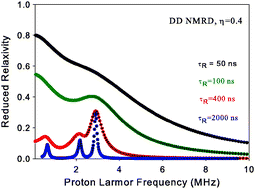The quadrupole enhanced 1H spin–lattice relaxation of the amideproton in slow tumbling proteins
Abstract
An analysis, based on the stochastic Liouville approach, is presented of the R1-NMRD or field dependent spin–lattice relaxation rate of ![[fraction three-over-two]](https://www.rsc.org/images/entities/char_e0ee.gif) )2
)2

a
Department of Chemistry, Biological and Computational Chemistry, Umeå University, 901 87 UMEÅ, Sweden
E-mail:
per-olof.westlund@chem.umu.se
Tel: +46907866344
An analysis, based on the stochastic Liouville approach, is presented of the R1-NMRD or field dependent spin–lattice relaxation rate of ![[fraction three-over-two]](https://www.rsc.org/images/entities/char_e0ee.gif) )2
)2

 Please wait while we load your content...
Something went wrong. Try again?
Please wait while we load your content...
Something went wrong. Try again?
P. Westlund, Phys. Chem. Chem. Phys., 2010, 12, 3136 DOI: 10.1039/B922817A
To request permission to reproduce material from this article, please go to the Copyright Clearance Center request page.
If you are an author contributing to an RSC publication, you do not need to request permission provided correct acknowledgement is given.
If you are the author of this article, you do not need to request permission to reproduce figures and diagrams provided correct acknowledgement is given. If you want to reproduce the whole article in a third-party publication (excluding your thesis/dissertation for which permission is not required) please go to the Copyright Clearance Center request page.
Read more about how to correctly acknowledge RSC content.
 Fetching data from CrossRef.
Fetching data from CrossRef.
This may take some time to load.
Loading related content
